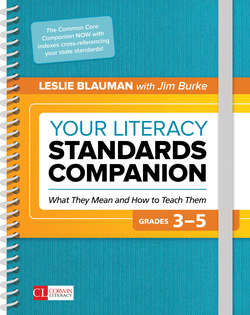Читать книгу Your Literacy Standards Companion, Grades 3-5 - Leslie Blauman - Страница 5
На сайте Литреса книга снята с продажи.
Contents
Оглавление1 Preface
2 Introduction: Turning Standards Into Daily Teaching
3 Key Principles and Additional Teaching Strategies for English Language Learners 3–5
4 Quick Reference: Common Core State Standards, K–12 English Language Arts
5 Indexes Cross-Referencing Your State Standards
6 The Complete Common Core State Standards: Decoded
7 Part 1. ReadingKey Ideas and Details1. Read closely for explicit meaning . . . make logical inferences . . . cite textual evidence2. Determine central ideas . . . analyze their development . . . summarize key details3. Analyze how and why individuals, events, and ideas develop and interactCraft and Structure4. Interpret words and phrases as they are used . . . and shape meaning or tone5. Analyze the structure of texts, including specific elements and sections6. Assess how point of view or purpose shapes the content and style of a textIntegration of Knowledge and Ideas7. Integrate and evaluate content presented in diverse media and formats8. Delineate and evaluate the argument and specific claims, including the validity9. Analyze how two or more texts address similar themes or topicsRange of Reading and Level of Text Complexity10. Read and comprehend complex literary and informational texts
8 Part 2. WritingText Types and Purposes1. Write arguments to support claims . . . using valid reasoning and . . . evidence2. Write informative/explanatory texts to examine and convey complex ideas3. Write narratives to develop real or imagined experiences or eventsProduction and Distribution of Writing4. Produce clear and coherent writing5. Develop and strengthen writing . . . by planning, revising, editing, rewriting6. Use technology . . . to produce and publish writing and to interact and collaborate . . .Research to Build and Present Knowledge7. Conduct short as well as more sustained research projects8. Gather relevant information from multiple . . . sources . . . avoiding plagiarism9. Draw evidence from . . . texts to support analysis, reflection, and researchRange of Writing10. Write routinely . . . for a range of tasks, purposes, and audiences
9 Part 3. Speaking and ListeningComprehension and Collaboration1. Prepare for and participate in . . . conversations and collaborations2. Integrate and evaluate information presented in diverse media and formats3. Evaluate a speaker’s point of view, reasoning, and use of evidence and rhetoricPresentation of Knowledge and Ideas4. Present information, findings, and supporting evidence5. Make strategic use of digital media and visual displays of data6. Adapt speech to a variety of contexts . . . demonstrating command of formal English
10 Part 4. LanguageConventions of Standard English1. Demonstrate command of the conventions of standard English grammar and usage2. Demonstrate command of the conventions of standard English . . . capitalization, punctuation, and spellingKnowledge of Language3. Apply knowledge of language to understand how language functionsVocabulary Acquisition and Use4. Determine or clarify the meaning of unknown . . . words and phrases5. Demonstrate understanding of figurative language, word relationships . . . nuances6. Acquire and use . . . general academic and domain-specific words and phrases
11 Part 5. Reading Standards: Foundational SkillsPhonics and Word Recognition3. Know and apply grade-level phonics and word analysis skills in decoding wordsFluency4. Read with sufficient accuracy and fluency to support comprehension
12 ResourcesResource A. Common Core Recommended Reading ListsResource B. Text Complexity ToolResource C. Planning Calendar Templates
